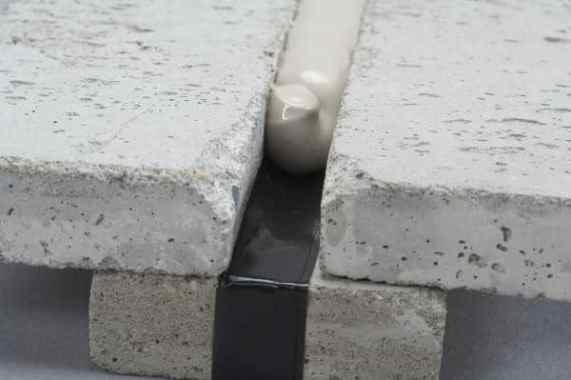Table of Contents
Sealing with polyurethane joint sealants
Polyurethane joint sealants have to meet various requirements depending on function and location of the respective joint. The purpose of joint sealing generally is to: ́ Prevent passage of media (air, water, chemicals, smoke etc.) ́ Provide thermal and sound insulation ́ Enhance the visual appearance of the construction.
Expansion Joints in between construction elements can be found in different parts of a construction, e. g. between precast concrete elements in facades, around windows and doors, between floors and walls, around storage tanks, etc. Joints sealants play a very important role here.
WHY ELASTIC/ Flexible SEALING?
Buildings and civil engineering structures consist of individual elements which exhibit relative movements to each other. There are two kinds of such movements:
1. Thermal movements :Temperature changes due to climatic, solar and weather effects results in expansion or contraction of the building elements. For the sealants connecting them this leads to permanent movement. In case of increasing temperatures, the elements expand, the joints become smaller and the sealant is compressed .
In case of decreasing temperatures, the elements shrink, the joints become larger and the sealant expanded or elongated.
In the latter case the adhesion of the sealant to the substrate is crucial. Thermal movements are considerably in case of large elements or when different materials are used for example a brick wall and vinyl window frame.
2. Structural movements: Structural movements can have several reasons. They can originate from settlement of the structure, vibrations or other loads like wind. Structural movements change the initial joint dimensions and consequently can apply considerable stress to the sealing material, often shear stress.
Movement within the joints is a reality and the long-term solution to accommodate them are high-performance elastic joint sealants. These sealants retain their original functionality and good adhesion to the substrate throughout their whole life cycle and provide durable tightness.
Benefits of using Polyurethane joint sealants
Supex provides a full range of polyurethane sealant and accessories for your construction with the following main advantages:
- Long-term elasticity to accommodate joint movements
- Good and durable adhesion to common construction materials to ensure durable tightness
- Perfect handling for efficient, reliable and attractive joint sealant application
- Visual appearance that meets the demands of architects and owners
- Excellent mechanical properties, chemical resistance and weather ability ensuring sustainable performance even under most adverse conditions and loads
- Technical support and training for architects, specifiers and applicators
Supex offers polyurethane sealant solutions for a great variety of applications:
- Building envelope joints like precast concrete facades, glass and metal facades, natural stone facades and joints in exterior insulation and finishing systems (EIFS) for wall cladding, Concrete Facade, Glass and Metal Facade
- Civil engineering joints in containment bunds of fuel stations, water and sewage treatment plants and swimming pools.
- Interior finishing joints in bathrooms and kitchens
- Floor joints
- Roof and flashing joints
- Sealing Joints on Metal Roofs
Supex polyurethane sealant makes construction joints sustainably air and water tight. The best performance for your application is the key issue; therefore Supex sealants produces high quality products in all major technologies.
Application advantages of polyurethane joint Sealants
The application properties of polyurethane joint sealants has a direct impact on the efficiency, reliability and appearance of the joint sealing job.
LOW EXTRUSION FORCE: For efficient application the sealant must be easy to extrude – even at low temperatures.
SHORT CUT-OFF STRING: Avoid unnecessary cleaning. Long cutoff strings will mess up your construction elements and permanently stain them.
NON-SAG BEHAVIOUR: Sealants must stays where they are applied. Non-sag behavior is essential when the joints are wide and in a vertical or overhead position. The rheology of facade sealants is designed not to flow or sag after application.
GOOD “BODY” AND TACK-FREE SURFACE: To achieve a visually attractive finish the sealant must be easy to tool. Supex sealants stand out due to their good body, tack-free surface and sufficient tooling time, even under warm and humid conditions – the prerequisite to perfectly shape and smooth out the sealant surface.
LOW SMELL AND LOW VOC: Being exposed to badly smelling products and volatile organic compounds (VOC) all day will make you feel bad. When creating our products we take care that their smell is not disturbing and the VOC meets the stringent market requirements
FACADE- Joint design for effective waterproofing with joint sealants
THE FACADE IS THE FACE of your building. In contemporary architecture the facade is of special interest expressed by large dimensions, unconventional shapes and high material diversity. Joint design is demanding and prone to mistakes. For integral joint specification, following some rough guidelines will result in a long-lasting and tight building envelope.
JOINT DESIGN FOR LONG-LASTING & TIGHT BUILDING ENVELOPE
A construction joint’s expected movement can be calculated from the dimensions and thermal expansion coefficients of the facade elements and the maximum and minimum temperature your facade will be exposed to. The expected movement and the sealant’s movement capability leads to a minimum joint width required to withstand the daily and seasonal cyclic movement. To simplify your choice, sealants are classified according to their movement class by several standards.
MATERIALS TO BE JOINED
Depending on the design of your facade, it may consist of facade elements of different materials like concrete, glass, metal, brick or stone, just to mention the most common ones. These elements have to be sealed to each other but also to other waterproofing products like membranes or structural glazing elements consisting of glass, spacer and adhesives. The sealant must show good adhesion to the adjacent materials and at the same time must be compatible with all materials to avoid discoloration, loss of adhesion over time or any changes of properties.
ENVIRONMENTAL EXPOSURE
Environmental conditions have an impact on the service life and the performance of the sealant. Expected UV and heat exposure as well as the chemical impact must be considered when choosing the product. Additionally, when sealing between the inside and outside of the building the vapor permeability of the sealant has to be considered to avoid accumulation of water in the walls. The general rule is to use a sealant with lower vapor permeability on the warm side of the wall, as warm air is generally more humid than cold air (or the same vapor permeability but thicker applied on the inside). APPEARANCE Ugly joints are like scares on a facade. Therefore, when specifying the joint sealant, the visual appearance and matched color of the joint is important. When sealing natural stone or glass a products staining and streaking must be checked as this would damage the appearance of the whole facade irreversibly. In this case stone and glass must be replaced. By using non-staining and non-streaking products where required money can be saved ultimately.
MECHANICAL EXPOSURE
Floor and some wall joints are exposed to mechanical impact. (Floor: Tyres, heels, tolly, fork lift, cleaning machines (high pressure water, brushes). Wall: People that pick and play with the sealants, especially in zones where they have to wait like bus stations). This impact damages the joint sealants. Therefore choose harder sealants, with high tear propagation resistance and plan recessed floor joints to avoid contact with the wheels.
JOINT DIMENSIONING
The design of a sealing system involves more than just the selection of a sealant with suitable physical and chemical resistance. In order to obtain optimal long-term performance the following considerations are essential as well:
- Proper joint design, including correct dimensioning and backup material selection
- Type and nature of substrates
- Application process and ambient conditions at the time of the installation
GENERAL RULES FOR JOINT DESIGN
Movement capability of the sealant and joint width must fit to the expected movement of the adjacent building elements.
Joint width: Must be designed according to the sealants movement capability Sealant dimensions: The optimal ratio of sealant width to depth is 2:1 for facade joints and 1:0.8 for floor joints
Joint depth: A joint must have sufficient depth so that backer rod and sealant fit inside.
Spacing between joints: In the following tables an example for joint dimensions for concrete elements and a sealant with 25% movement capability are given:
| Facade Joints | Interior Floor Joints | Exterior Floor Joints | ||||||
| Joint spacing | Minim. joint | Sealant depth | Joint spacing | Minim. joint | Sealant depth | Joint spacing | Minim. joint | Sealant depth |
| (m) | width (mm) | (mm) | (m) | width (mm) | (mm) | (m) | width (mm) | (mm) |
| 2 | 15 | 8 | 2 | 10 | 12 | 2 | 12 | 10 |
| 4 | 20 | 10 | 3 | 10 | 12 | 3 | 12 | 10 |
| 6 | 25 | 12 | 4 | 10 | 12 | 4 | 15 | 12 |
| 8 | 30 | 15 | 5 | 10 | 12 | 5 | 18 | 15 |
| 10 | 35 | 18 | 6 | 10 | 12 | 6 | 20 | 17 |
| 8 | 10 | 12 | 8 | 30 | 25 | |||
The sealant must be capable of extending and contracting along with the building elements to which it is joined. If this is not possible the consequence may be adhesive and/or cohesive failure.
The sealant depth defines the stress at the sealant/substrate interface. If the sealant depth is too large this will lead to severe stress on the interface at low temperatures and finally adhesion failure.
3-side adhesion must be avoided. Any other adhesion than to the joint flanks leads to massive reduction of the elasticity and movement capability of the sealant and consequently to failure of the sealant. The correct use of backing material can avoid these problems. The backer rod defines the joint depth and avoids 3-side adhesion.
FLOOR JOINT DESIGN
Depending on the location and expected loads of a floor joint special design considerations for floor joints are necessary. Generally high modulus sealants are recommended for floor joint applications.
Joints in areas with a lot of car and/or equipment traffic should be recessed to reduce mechanical loads.
Joints in pedestrian areas should be flush with the surface to prevent tripping hazard. The sealant must also have a certain hardness and indentation resistance due to high mechanical impacts from narrow heels.
HOW TO ENSURE GOOD ADHESION with Polyurethane sealant
SUBSTRATE PRE-TREATMENT – PRIMERS, ACTIVATORS AND CLEANERS
Strong and durable adhesion of the sealant to the substrate is the essence of joint sealing. No adhesion means water ingress. Therefore, we recommend to pre-treat the joints be-fore sealant application. The effort and cost of pre-treatment before the initial sealant application is very small with regard to the gain in durability and service life of the joint.
Primer application does not replace the usual joint prepara-tion. Before the primer and sealant application, the joint must be well cleaned from all processing agents, dirt and dust. In case of concrete, the laitance must be removed by grinding and loose particles, dust etc. must be removed. The substrate surface must be capable to withstand the elastic forces from the sealant movement. If this rule is disobeyed, the substrate will crack near the surface. Therefore a serious substrate preparation is essential.
Good adhesion is achieved by several means on the different substrates:
For porous substrates the primer closes the porosity, Im-proves the wetting of the surface with the sealant, guar-antees best possible chemical bonding and prevents water penetration at the substrate-sealant interface. For joints with periodic water immersion, the pre-treatment with a primer is mandatory.
́́For non-porous substrates the treatment is chosen accord-ing to the material:
Metals and powder coated metals: Besides cleaning and removing processing agents from the surface, activators leave adhesion promotors on the surface to ensure good adhesion. Cleaners are special solvents to clean the sub-strate surface. Primers are used to ensure good wetting of the sealant.
Plastics: Independent of the sealant technology adhe-sion to plastics often is difficult to achieve. Therefore, activators and primers are used. They change the surface energy to enable durable adhesion.
Glass: Generally, glass only needs to be cleaned before sealant application. As some cleaners may leave visible stains on the glass, special products are used here.
Supex PU 25 Polyurethane sealant
How to use polyurethane sealants
TO CREATE VISUALLY APPEALING AND DURABLE JOINTS, you have to consider several points. A description for the procedure valid for porous substrates such as precast concrete is shown below. In the case of non-porous substrates the surface preparation is usually different, but the other steps are identical application procedure stays the same.APPLICATION STEPS
Surface preparation: Grind the substrate with a wire brush or other equipment tool, and remove dust and friable particles. Backer rod installation: Insert a fitting backer rod to the required depth. The diameter of the backing rods should be 20 – 30% larger than the joint width. If using a closed cell polyethylene backer rod pay attention when inserting the rod not to damage it for example by using a sharp tool like a screwdriver. Use a blunt tool to insert the backer rod. Masking tape and primer application: If sharp and exact joint lines are required place a masking tape. Take care that the tape is well attached to the surface to avoid spread of the primer below the tape. Apply primerin the area where the sealant is supposed to be apllied later. Sealant application: Fill the joint with sealant avoiding air entrapment. Remove excess material. Make it look nice: Remove the masking tape before skin formation. Smooth the joint sealant with smoothing liquid for a perfect finishJOINT RENEWAL AND REPAIR
REASONS FOR JOINT REPAIR
A careful visual inspection is usually enough to determine if the joint sealing is improper or worn out and a replace-ment is needed. Reasons for joint refurbishment may include but are not limited to the following:
- Failures in workmanship
- Use of unsuitable type of sealant
- Wrong joint design
- Underestimated load
- Sealant reached end of its service life.
- Compatibility issues with adjacent materials (e. g. gaskets)
- Exposure to aggressive chemicals
- Insufficient surface preparation (loss of adhesion
Following steps should be done:
- Remove old sealant. Up to 0.5 mm of the old sealant can be left on the sur-face if the substrate and the adhesion are still in good shape.
- Make sure that the substrate & joint flanks are still strong. In areas with adhesion loss, mechanical cleaning of the bonding area is mandatory.
- In order to ensure long-term durability and tightness of the newly sealed joint both the substrate surfaces as well as the old sealant residues should be pre-treated using the primer recommended.
- Use the same sealant technology as before. Replace polyurethane with polyurethane, silicone with silicone, etc. If the reason for sealant replacement is some kind of incompatibility with the substrate or any adjacent material check with your Supex representative for a compatible solution



3 thoughts on “Best Joint Sealants for construction”
Polyurethane sealants are perfect for construction joints, and I know it now. I will purchase a few of these things and use them for my stone project. It will be great, and I will enjoy this time.
we require the PU sealent for Construction expansion joint filling
Thank you for the enquiry, request your contact details. Else kindly call 18001214771 / Email: sales@anaghaengineers.in